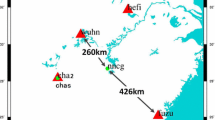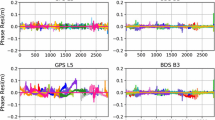Abstract
Improving ambiguity resolution (AR) in multi-frequency undifferenced and uncombined precise point positioning (PPP) benefits from accurate uncalibrated phase delays (UPD), which are often estimated from linear combinations of float ambiguities. The traditional linear ambiguity combinations for estimating these UPDs in case of triple-frequency observations are typically extra-wide-lane, wide-lane, and L1 combinations. We proposed the method for estimating UPDs from triple-frequency ambiguities using maximal decorrelated linear ambiguity combinations obtained by the least-squares ambiguity decorrelation adjustment Z-transformation. To validate the quality and availability of estimating UPDs for the BeiDou navigation satellite system, based on maximal decorrelated linear ambiguity combinations, tests using observations from stations of the Crustal Movement Observation Network of China and the Asia-Pacific Reference Frame project are performed using undifferenced and uncombined PPP-AR. The results show the internal precision of combined satellite UPDs estimated from the maximal decorrelated linear ambiguity combinations is better than that estimated from traditional combinations in terms of temporal stability and RMS of posteriori residuals. Furthermore, the statistical results also demonstrated that triple-frequency PPP-AR using the improved UPDs reduces the average convergence time by 8.9 and 12.3% in horizontal and vertical directions, and also improves the positioning accuracy for 3 h of observations by 11.1, 9.1 and 8.3% in the east, north and up directions, respectively, compared with triple-frequency PPP-AR using the UPDs derived from the traditional combinations.











Similar content being viewed by others
References
Boehm J, Heinkelmann R, Schuh H (2007) Short note: a global model of pressure and temperature for geodetic applications. J Geod 81(10):679–683
Collins P, Bisnath S, Lahaye F, Héroux P (2010) Undifferenced GPS ambiguity resolution using the decoupled clock model and ambiguity datum fixing. Navigation 57(2):123–135
De Jonge P, Tiberius C (1996) The lambda method for integer ambiguity estimation: implementation aspects. Technical Report LGR Series, No. 12
Deng Z, Zhao Q, Springer T, Prange L, Uhlemann M (2014) Orbit and clock determination-BeiDou. In: Proceedings of IGS workshop 2014, June 23–27, 2014, Pasadena, USA
Dilssner F, Springer T, Schönemann E, Enderle W (2014) Estimation of satellite Antenna Phase Center corrections for BeiDou. In: Proceedings of IGS workshop 2014, June 23–27, 2014, Pasadena, USA
Ge M, Gendt G, Rothacher M, Shi C, Liu J (2008) Resolution of GPS carrier-phase ambiguities in precise point positioning (PPP) with daily observations. J Geod 82(7):389–399
Geng J, Shi C (2017) Rapid initialization of real-time PPP by resolving undifferenced GPS and GLONASS ambiguities simultaneously. J Geod 91(4):361–374
Gu S, Lou Y, Shi C, Liu J (2015) Beidou phase bias estimation and its application in precise point positioning with triple-frequency observable. J Geod 89(10):979–992
Guo F, Zhang XH, Wang JL, Ren XD (2016) Modeling and assessment of triple-frequency BDS precise point positioning. J Geod 90(11):1223–1235
Laurichesse D, Mercier F, Berthias JP, Broca P, Cerri L (2009) Integer ambiguity resolution on undifferenced GPS phase measurements and its application to PPP and satellite precise orbit determination. Navigation 56(2):135–149
Li X, Zhang X (2012) Improving the estimation of uncalibrated fractional phase offsets for PPP ambiguity resolution. J Navig 65(3):513–529
Li X, Ge M, Dai X, Ren X, Fritsche M, Wickert J, Schuh H (2015) Accuracy and reliability of multi-GNSS real-time precise positioning: GPS, GLONASS, BeiDou, and Galileo. J Geod 89(6):607–635
Li P, Zhang X, Ren X, Zuo X, Pan Y (2016) Generating gps satellite fractional cycle bias for ambiguity-fixed precise point positioning. GPS Solut 20(4):771–782
Li X, Li X, Yuan Y, Zhang K, Zhang X, Wickert J (2017) Multi-GNSS phase delay estimation and PPP ambiguity resolution: GPS, BDS, GLONASS, Galileo. J Geod 92(6):579–608
Li P, Zhang X, Ge M, Schuh H (2018) Three-frequency BDS precise point positioning ambiguity resolution based on raw observables. J Geod 5:1–13
Liu T, Yuan Y, Zhang B, Wang N, Tan B, Chen Y (2016) Multi-GNSS precise point positioning (MGPPP) using raw observations. J Geod 91(3):253–268
Odijk D, Zhang B, Khodabandeh A, Odolinski R, Teunissen PJG (2016) On the estimability of parameters in undifferenced, uncombined GNSS network and PPP-RTK user models by means of S-system theory. J Geod 90(1):15–44
Odijk D, Khodabandeh A, Nadarajah N, Choudhury M, Zhang B, Li W, Teunissen PJG (2017) PPP-RTK by means of S-system theory: Australian network and user demonstration. J Spat Sci 62(1):3–27
Petit G, Luzum B (2010) IERS Conventions 2010 (IERS Technical Note No. 36). Verlag des Bundesamts für Kartographie und Geodäsie, Frankfurt am Main, p 179
Schönemann E, Becker M, Springer T (2011) A new approach for GNSS analysis in a multi-GNSS and multi-signal environment. J Geod Sci 1(3):204–214
Teunissen PJG (1995) The least-squares ambiguity decorrelation adjustment a method for fast GPS integer ambiguity estimation. J Geod 70(1–2):65–82
Teunissen PJG (1997) On the GPS widelane and its decorrelating property. J Geod 71(9):577–587
Teunissen PJG, Joosten P, Tiberius C (2002) A comparison of TCAR, CIR and LAMBDA GNSS ambiguity resolution. In: Proceedings of ION GPS 2002, Institute of Navigation, Portland, OR, September 24–27, pp 2799–2808
Wu J, Wu S, Hajj G, Bertiger W, Lichten S (1993) Effects of antenna orientation on GPS carrier phase. Manuscr Geod 18:91–98
Zhang B, Teunissen PJG, Odijk D (2011) A novel undifferenced PPP-RTK concept. J Navig 64(S1):S180–S191
Acknowledgements
The authors were grateful to the many individuals and organizations who contributed to the International GNSS Service. We also gratefully acknowledged the use of Generic Mapping Tool (GMT) software. This research was funded by National Science Fund for Distinguished Young Scholars (Grant no. 41825009), the National Key Research and Development Program of China (nos. 2016YFB0501803, 2017YFB0503402), National Natural Science Foundation of China (no. 41774034), and the project of Wuhan Science and Technology Bureau (no. 2018010401011270).
Author information
Authors and Affiliations
Corresponding author
Additional information
Publisher’s Note
Springer Nature remains neutral with regard to jurisdictional claims in published maps and institutional affiliations.
Rights and permissions
About this article
Cite this article
Liu, G., Zhang, X. & Li, P. Estimating multi-frequency satellite phase biases of BeiDou using maximal decorrelated linear ambiguity combinations. GPS Solut 23, 42 (2019). https://doi.org/10.1007/s10291-019-0836-0
Received:
Accepted:
Published:
DOI: https://doi.org/10.1007/s10291-019-0836-0




